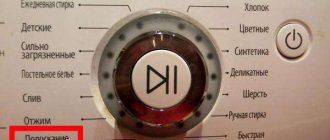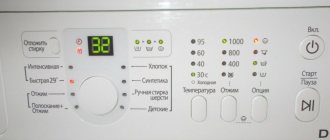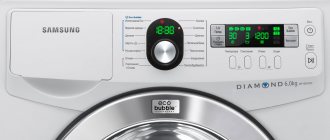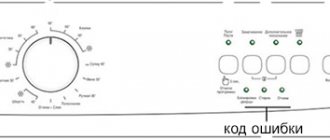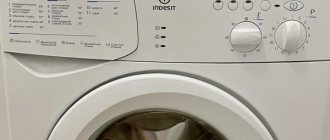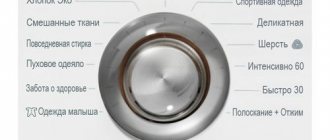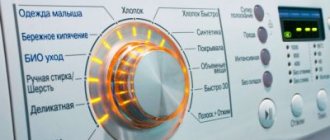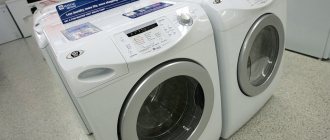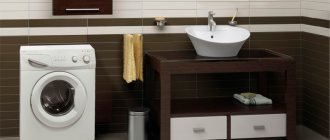Technological progress does not stand still: modern washing machines provide a lot of possibilities to their users. Just 5-10 years ago, technology could perform only a narrow range of functions, literally 3-5 basic modes. For some, this is already enough, but if you want to get the most out of your new washing machine, we recommend reading the current blog to the end. We will introduce you to the most popular and high-tech functions of washing machines to facilitate the process of choosing equipment.
Taking into account the functionality when buying a new washing machine is not just desirable, but necessary. This factor primarily affects the “usefulness” of the technology for you. You must decide what you want from your future machine, otherwise it will be useless in everyday life. A competent approach to selection will save you from overpaying - multifunctional models are now expensive. If one or another program that is included in the functionality of the washing machine is unnecessary for you, you should think about the feasibility of the purchase. The assortment on the modern market is huge - choosing equipment with the ideal set of modes is not difficult.
We will only orient you among the “fashionable” trends in the production of washing equipment. Everyone should learn more about the modern functions of washing machines - even if you are not going to change your old washing machine, it never hurts to be aware of new products. The question of replacing the machine will arise sooner or later, and that’s when this knowledge will come in handy.
Autodosing of detergents
Automatic dosing of detergents is one of the latest developments, which is found in the products of a few global manufacturers, for example, Miele and Siemens. It would seem, what’s the problem with putting the required amount of powder or liquid into the dispenser? It takes a few seconds - why overpay for an “unnecessary” function?
If you want to save money when buying a washing machine, perhaps giving up auto-dosing is the best option. Although this option is not paramount for the user, it contains many more advantages than it might seem at first glance. Automatic machines with automatic dosing of detergents have a different design from the standard one. To be more precise, the dispenser is designed differently. It has two corresponding compartments, UltraPhase 1 and UltraPhase 2 (in the case of Miele models), which are larger in volume than conventional ones. Autodosing technology in Miele washing machines comes in several variations, one of which is TwinDos.
To start washing, you don’t even need to add anything - liquid detergents are placed in special trays directly in the packages. The thoughtful design of the dispenser reduces the user’s contact with the equipment to a minimum - by placing the bottle in the container, you can forget about “refilling” for at least 10-15 washes. During washing, the equipment removes the required amount of product based on the operating settings of the cycle. That is, the duration of the selected program, the type of clothing and its soiling, and so on. As a result, according to the developers, TwinDos will save up to 30% of liquid products, without compromising washing efficiency! If you take into account the prices for high-quality cleaning products, then this is a very significant advantage.
Another technology owned by Mila is AutoDos autodosing. It, unlike TwinDos, helps to save not only liquid product, but also powder. The dispenser includes two 4-liter containers, which is enough for as many as 100 washes. For obvious reasons, such a large device is not located in the washing machine, but outside. The detergent enters the tank through special communications. And that's not all: the powder tray has a mechanical leavener at the bottom. It stirs the powder, eliminating lumps and other defects that make it difficult to move through the hoses. After loosening, the dry product is mixed with water and goes into the washing machine.
The main advantage of the AutoDos system is that it consumes exactly as much detergent as is needed for a specific operating cycle of the machine. A lack of powder reduces the effectiveness of washing, and there is nothing good in an overdose - soap stains remain on clothes, and allergic reactions may begin if there is a predisposition. Autodosing in a washing machine eliminates these problems, and also saves money - a useful and profitable technology.
Which PMMs have a cleanliness sensor?
The pioneers in using a sensor that monitors the degree of contamination of the liquid in the dishwasher bin were the brands Bosch and Siemens. You won’t find such a part in cheap designs - it is used only in PMM of the “Standard” and “Premium” classes. So, the sensor is built into the following models:
- Electrolux ESL 94510 LO is a narrow, fully built-in machine with 9 place settings and 5 programs.
- Electrolux ESL 94320 LA is a similar model with similar characteristics.
- Asko D 5436 W is a full-size stationary model designed for 13 sets. Equipped with a “Turbo” dryer and 6 washing modes.
- The Vestfrost VFDW6053 is a full-size fully integrated machine with a hopper for 15 place settings. 8 programs and “Turbo” drying.
- Bosch Serie 4 SMV 44KX00 R is a built-in full-size PMM that can accommodate 13 cookware sets. There are 4 programs in total, with beam projection on the floor.
The price range of these models ranges from 20-40,000 rubles. In more expensive cars, costing 50-100,000 rubles, the sensor in question is almost always present.
Even a small - miniature or compact - dishwasher can have such a sensor installed. The size of the PMM does not matter, the main thing is to ensure efficiency, so feel free to select the appropriate form factor for your future assistant.
In different brands of machines, the option for monitoring water purity has different names. So, in Miele dishwashers this is called “Eco sensor”. Manufacturers of Hotpoint-Ariston brand dishwashers gave the name Sensor System.
So, thanks to such a useful sensor:
- The number of rinses is adjustable to save water;
- Cycle time is reduced;
- Electricity consumption is reduced.
Washing machines and dryers
Those who have already given preference to a washer and dryer, judging by the reviews, do not regret their decision at all. Of course, with this technique you don’t have to wait several hours for the laundry to dry, hang it on the balcony before hanging it, and then take it off. All this takes a lot of time and effort, but this can be easily avoided by drying. Installations with this function are called washer-dryers, and they also have their own design features. They are connected with the operating principle of automatic drying: when hot air absorbs moisture from washed items, it needs to condense somewhere. A separate tank is provided for this.
It is worth noting that washing machine manufacturers still place more emphasis on washing performance and quality - not much attention is paid to drying, it is just an additional option. Therefore, modern washing machines can dry a maximum of 5 kg of laundry, and 2-3 modes are offered for this. If you want even more productive equipment for drying things, think about buying a full-fledged drying machine - it has wider functionality and a larger load capacity.
In most washer-dryers, you can dry clothes according to the standard program using the timer. But particularly “smart” models can decide for you how long it takes for 100% drying. These are washing machines with Fuzzy Logic technology, which uses sensors to determine the degree of humidity of things. For those who use timed drying, a little advice: you don’t need to let your laundry dry completely. Firstly, such drying harms fabrics, especially delicate ones - the material overheats and becomes less durable. Secondly, ironing such clothes is more difficult, but semi-damp ones are much faster and easier.
Premium washing machines also help in removing wrinkles from clothes; there are special drying programs for this. For example, “in the closet” or “under the iron.” The latter is effective when the user is going to iron the laundry after drying - it remains slightly damp and unwrinkled. And the “closet” program often eliminates the need for ironing altogether - clothes can be put on immediately after heat treatment. Due to the moderate rotation of the drum, practically no folds are formed, and as a result the item looks neat.
Wi-Fi and NFC
Top manufacturers began equipping their washing machines with Wi-Fi some time ago, but only recently did this function finally find practical application - at one time it could only be used to send error messages to technical support and receive signals from the machine that something had gone wrong not this way.
The Candy GVF4 137LWHC/2 washing machine with Wi-Fi and NFC modules remembers preferences and offers washing options taking them into account
Now, with the help of NFC and Wi-Fi, the smartphone turns into a convenient machine control panel: using the application, the user can start a wash cycle, stop it, configure individual parameters and see when the wash is finished.
Through the application, the user can download and install new washing modes in the machine
Of course, on the one hand, there is a delayed start, which can be activated while still leaving home. On the other hand, the whole process is visible on a smartphone, and knowing that everything is going fine is somehow calmer. Well, or you can run a wash cycle and start the spin cycle when you get to the house to get and hang fresh laundry.
Vibration reduction system
Vibration of a washing machine is an absolutely normal phenomenon, since the laundry has its own weight, and the drum sometimes rotates at the highest speeds (up to 1600 and even 2000 rpm). Manufacturers do everything to reduce the noise level to a minimum - there are counterweights in the drum design, shock absorbers are attached to the tank, and so on. But this does not always save you from vibrations - there are many external factors that provoke this problem. For example, overloading the tank or uneven distribution of things throughout the drum. In old washing machines this was impossible to notice, but in new ones there is a whole indication system.
In some cases, the technology handles everything itself, and does not even require intervention from the owner. If excessive vibration occurs in the washing machine, the sensor is triggered and the system adjusts the rotation speed of the drum. First, it rotates alternately in different directions to eliminate overload - things are distributed more evenly, and the machine goes into intensive spin mode. If this does not solve the problem, the washing machine stops washing completely and displays the corresponding error code. Then the user should refer to the instructions, where there is a transcript and instructions for action. The owner needs to lay out the laundry manually on the drum.
The vibration reduction system is not just a function that makes the machine quiet. This is a technology that prevents a number of serious breakdowns. Professional craftsmen often note that the cause of malfunctions of the drum, bearings, motor and other key components is precisely overload with laundry. The “smart” program prevents these and other problems, which means it saves you money on service at the service center.
Pros and cons of smart technology
Any technology that takes care of saving money and provides ease of remote and other control is a good technology. Regardless of the manufacturer, a smart washing machine has a number of significant advantages:
- saving time, since washing does not require human presence;
- remote access from anywhere in the world;
- ease of management thanks to the user-friendly software interface;
- possibility of remote diagnostics;
- saving water and detergents;
- minimum energy consumption.
At the same time, one cannot fail to note the significant disadvantages of such technology. The first and most significant of them is price. For remote control and additional functions you will have to pay extra, often this amount is impressive. The second disadvantage is the complexity of the control module; in case of failure, it is completely replaced.
Reducing water consumption
Rational use of water is a pressing issue for everyone who uses automatic washing. Despite the obvious resource savings compared to hand washing, consumer demand is growing. And brands are developing new technologies to reduce water waste. All of them work according to the Fuzzy Logic type, which translated from English means “fuzzy logic”. In this mode, economical washing machines do not consume any standardized amount of water - its volume is determined by the weight of the clothes and the degree of contamination.
To do this, the tank has a system of touch sensors that are activated when the machine is filled with water. The system analyzes how dirty things are and what type of dirt they are. And then the control unit automatically calculates the required consumption of water, electricity (the required heating temperature), as well as detergents - we have already discussed this aspect above. Some washing machines even control suds levels for first-class care for your clothes.
There are other modern programs to reduce water consumption. For example, “Half load” or “Quick wash”, “Eco” mode. Just keep in mind that each of them has its own loading volume and intensity of contamination of things. If the user does not comply with these requirements, the washing efficiency will be significantly reduced.
Removing stains
Many people complain that their washing machine does not always remove stains and even pre-soaking and washing does not help to deal with them. A Siemens development called Stain Removal solves the problem of removing 16 types of stains with a unique washing algorithm for each of them. The user selects the type of stain in the menu, and the machine decides what temperature, mode, and amount of water will be most effective in this case.
Hotpoint-Ariston's stain removal cycle is designed for as many as 20 types. Typically, such programs wash clothes at a temperature of 40 ° C. But in order for all types of enzymes (active substances in the powder) to act on contaminants, the water temperature changes during operation (either increases or decreases). This ensures maximum impact of all components of the powder on different stains.
Leak protection
All manufacturers call the leakage protection system differently, but initially it was called AquaStop. The first analogue was developed back in the 90s, but now the technology has been significantly improved. First, let's look at the structure of a washing machine with the Aquastop function. At first glance, this technique has no external differences - except perhaps the unusually thick inlet hose. And this is due to additional sealing - the system reliably protects against leaks. At the junction of the communication with the machine there is a small box where, in addition to the main one, there is another backup inlet valve. It, like the first one, is in a closed state, and opens only when the washing machine is turned on.
At the bottom of the machine structure there is a special tray - also an element of the AquaStop system. When some kind of leak occurs, all the water inevitably gets here, to which the sensor float reacts. It rises and closes the microswitch contacts. And this is a direct signal to close the intake valve. There are simply no errors in this technology - the system is very simple, and therefore reliable. Aquastop will work in case of any problems associated with leaks: damage or overfilling of the tank with water, leaks of both hoses. The leakage protection system closes the valve even if there is excessive foaming, if the foam suddenly leaves the tank.
Even if some accidental failure suddenly occurs and the valves do not work, in this case an emergency water pumping system is provided - the developers have provided for literally everything.
Reloading laundry
In fact, the reloading function means that at any time you can add laundry that was forgotten during the main load into the drum, and for this you don’t have to dance around the machine: remember how to make an emergency stop of the cycle, wait until the lid is unlocked, start the wash again, in the end . At first, this function was equipped with top-loading machines, but now front-loading washing machines also have it.
Washing machine Hansa Crown WHC 1456 IN with the ability to reload even during spinning and rinsing
The most famous option is Samsung's AddWash - the Koreans added a small door to the loading hatch. To add laundry, you just need to pause the wash, open this door, add the forgotten laundry and continue the cycle. It is convenient to use AddWash not only in case of forgetfulness, but also when you need to wring out some hand-washed item or simply add conditioner or laundry detergent. The only “but” is that the dimensions of the hatch are small, and any large thing simply will not fit through there.
Samsung is so far the only manufacturer that has provided a reloading door on the hatch
Other manufacturers do not provide an additional door on the hatch, but in some models the reloading function is still present. So, Bosch or Hansa machines have an electromagnetic lock for these purposes, and the “Start” button is combined with a pause: the user presses it and waits until a signal appears on the display that the door can be opened.
Steam wash
Steam washing is one of the most original innovations proposed by the Korean company LG. Washing machines with this function are divided into two types: models with and without a steam generator. The former provide better quality steam treatment, but the latter are cheaper. What exactly to choose, the consumer decides for himself.
In general, steam washing has been used for a long time, but not for household, but for industrial washing: in dry cleaners, laundries. The technology has undeniable advantages. Firstly, it allows for the most delicate care of smooth fabrics. Secondly, steam smoothes out any wrinkles, even on cotton fabric, which loves to wrinkle. For those who plan to use steam washing often and a lot, we recommend paying attention to multifunctional models. They are usually equipped with three types of steam modes: for cotton (30-35 minutes), synthetics (about 20 minutes) and “fast” (15 minutes) to refresh things.
Another important point is that steam washing technology often allows you to abandon the use of detergents. This is an obvious savings and a big plus for families with small children or people with allergies.
Drum rotation algorithms
Technology is a clear example of how to truly care. Engineers have developed a special 6 Motion reel, which has as many as 6 spin options (1 basic and 5 additional).
Each movement algorithm is adapted to the type of fabric and the number of loaded items, ensuring the most gentle care for them.
All six algorithms are selected automatically based on the selected program. Today, LG’s “6 care movements” technology has no analogues. But who knows, maybe tomorrow we will have to supplement the article with information about another development.
Fighting allergens
In this matter, steam washing is considered one of the most effective methods. Thanks to it, you don’t have to use washing powder, and it also effectively removes almost all allergens. But there are other powerful features that make things safe for those who have allergies to dust, tobacco and other substances. For example, a hypoallergenic mode with increased water temperature - up to 60? C. This program is also used for washing children's clothes. In fact, the hypoallergenic mode completely sterilizes things: gets rid of stains, odors and allergens. It is also distinguished by rinsing, which occurs in several stages - all for thorough and safe sedum.
Connection method
The washing machine can be connected:
- only to cold water;
- to both cold and hot water.
The first connection option is associated with higher energy costs, however, by heating the water to the required temperature, the quality of the wash will be much higher. With the second connection option, washing efficiency may suffer due to instability of the hot water temperature.
That is why the choice should be made in favor of a washing unit connected only to cold water supply.
Modern Miele washing machines
For those who are thinking about purchasing a modern high-tech washing machine, we advise you to pay attention to Miele. This is a German manufacturer that quite successfully competes with such giants as Bosch or LG. Moreover, the company has its own patented technologies, which at one time had a huge impact on the field of household appliances. If we talk about washing machines, then this is the development of a honeycomb drum. It makes washing more gentle and efficient due to a smoother surface texture.
It is worth considering the option of a washing machine with an inverter engine - the Miele range just accommodates many inverter models with a different set of functions. The advantages of such washing machines: low noise and vibration levels, longer service life, less susceptibility to breakdowns.
And, of course, Miele washing machines include all the programs and options described above. The main thing is to choose the combination that is optimal for you so that the purchase justifies itself. To do this, visit our catalog and place an order on the website. From us you can buy a Miele washing machine at the manufacturer's price and with an official guarantee.
Embossed drums
Many manufacturers focus on expanding the capabilities of the SMA drum, since it is the one that comes into direct contact with clothing during rotation. It is important that this contact is as gentle as possible, but at the same time effective.
Miele engineers did their best in this regard and developed the SoftSteam .
Its surface is covered with small hexagonal protuberances, reminiscent of a honeycomb. This design forms a thin film of water between the walls and clothing. This promotes smooth sliding of the fabric over the surface, minimizing friction.
The Diamond Drum washing drum was developed by Samsung engineers using the above-described Miele technology. But it has a slightly different structure. Its inner part is covered with quadrangles, and the perforation holes are located in their recesses. During operation, water accumulates in the honeycombs, creating a smooth surface for gentle washing. In Diamond Drum, the fluid drain holes have been reduced in diameter by 25%. Therefore, the likelihood that the fabric will get caught in them and be damaged is minimal.
But the surface of the VarioSoft from Bosch has a teardrop shape with flat and steep sides. The intensive wash program exposes clothes to steep protrusions. If a cycle is started for delicate fabrics (silk or woolen products), then rotation occurs from the side of the flat grips. Thus, the mechanical effect will either increase or, conversely, weaken.
Sensor design
The design of the pressure switch is round, with adjusting screws and flat-shaped contacts located on the outside. Moreover, the function of the screws is to set and regulate the switching on and off of the pumping device at a given water level. There is a separate pair for the water level mode, namely:
- To fully load the drum.
- If the unit is only half loaded.
- “Delicate wash” mode.
4.Eco mode.
One screw is supposed to turn on when the set level is reached, and the second works to turn off.
The range of offered machines differs in the number of modes, that is, the sensor is adjusted for a specific model. To purchase a replacement element, you must tell the seller the name of the model, since an analogue from other equipment will not work.
The heads of the screws themselves are painted, this allows them to be unscrewed and installed unmistakably, and the color itself acts as a seal for the assembly. If the coating is damaged, then we can say that the warranty will not automatically apply.
The cylinder is structurally provided with a chamber for air, connected together with a tube, which in turn is lowered into the tank. When water is collected, the pressure indicator increases and a notification is transmitted from the built-in membrane to the signal contacts.
The terminals are in one row and located along the entire plane of the sensor, after which a terminal block with wiring is installed on them, directed to the immediate program. From the end, a tube of different sizes is lowered into the tank.
